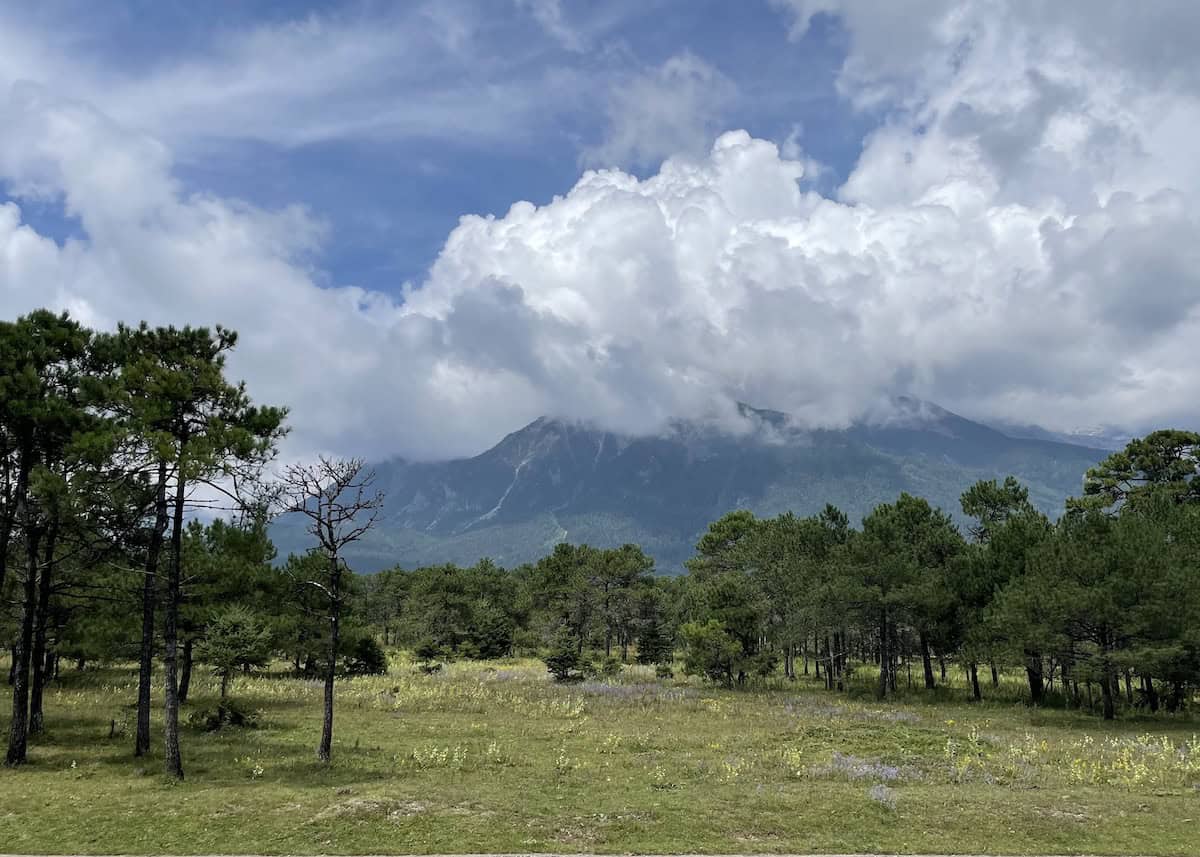Jade Dragon Snow Mountain. The name sounds like something out of an ancient myth or a 70s Kung Fu movie. The mountain towers over the city of Lijiang in the Northwest corner of China’s Yunnan province, at the far edge of the Tibetan plateau. It’s the Southernmost snow-capped mountain in the Northern Hemisphere and was worshiped by the ancient people living in the area.
How to get from Lijiang to Jade Dragon Snow Mountain
While you can see the Jade Dragon Snow Mountain from almost anywhere in Lijiang, especially at the Black Dragon Pool, it’s also fairly easy to get up close and personal. The Jade Dragon Snow Mountain Scenic Area is only about an hour or so outside of Lijiang’s Old Town.
It’s easy to catch a taxi there, although you have to be careful. As is the case with Cangshan Mountain in Dali, some drivers might try to scam you. The taxi driver will ask you if you need a jacket and oxygen containers. If you say “yes” he’ll take you to a local shop, where you’ll be charged an arm and a leg and possibly a few other body parts.
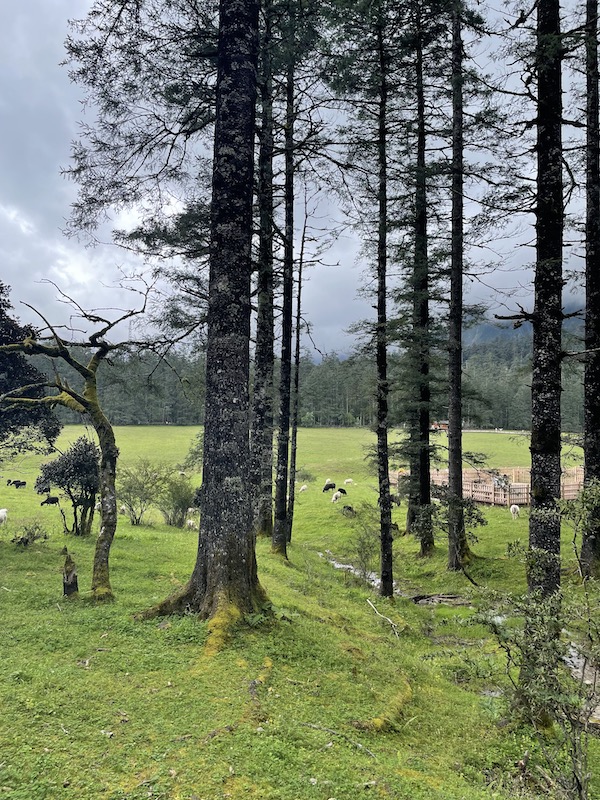
You can buy plenty of oxygen inside the park itself, or even in local convenience stores, for far cheaper. The park even rents jackets if you forgot to pack one. Save your money and tell the taxi driver you already have everything you need.
The bus is much cheaper than a taxi and still convenient. There’s a regular bus service from Lijiang Old Town to the mountain, and you won’t have to worry about being pressured into buying expensive oxygen. Any hotel in Lijiang should be able to help you get on the right bus.
Whichever way you go, your driver will stop at the entrance gate and you’ll fork over 100 RMB (about $14 bucks) for a ticket. The cable cars going up the mountain cost extra, but are all under $10. Jade Dragon Snow Mountain’s main visitor center has pretty good English signage that will direct you to whichever shuttle bus you need to get you wherever you want to go within the park.
Spruce Meadow
One place you might want to go to is Spruce Meadow. The Spruce Meadow is probably the second most popular section of the Jade Dragon Snow Mountain. Local legend has it that star-crossed lovers would come here to commit suicide. How romantic!
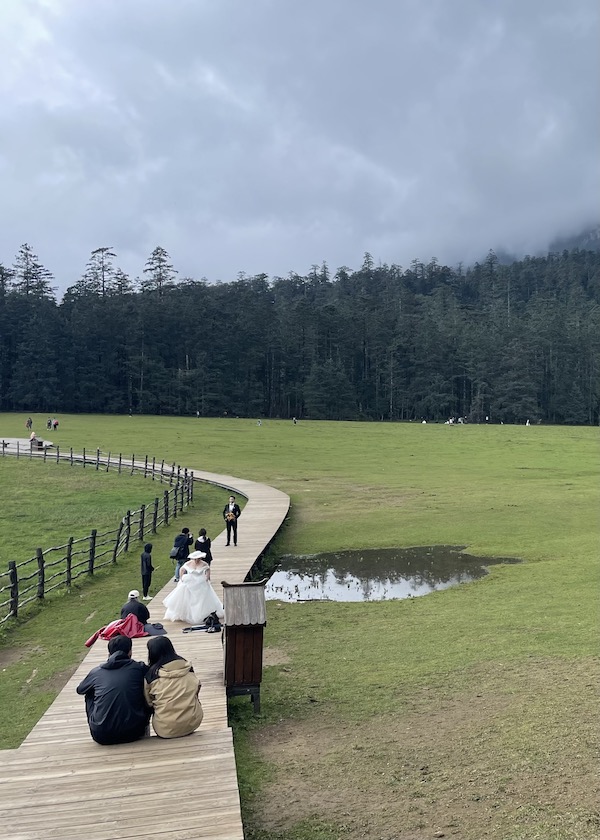
A long boardwalk trail winds through a forest of thick green spruce trees and large mossy boulders. The scenery reminded me of the Pacific Northwest in the United States. Tall trees, moss, and wet, wet green.
I saw a woman and two children walking in the forest a long way off the trail. It took me a minute to realize it was a local grandmother teaching her grandchildren how to forage. They were collecting mushrooms.
Eventually, the forest opens up into a wide alpine meadow. Baby goats and sheep graze on the grass. Modern-day lovers come here to get their wedding photos taken. There were at least 12 couples doing photo shoots when we were there.
We heard a noise like some kind of otherworldly beast echoing through the meadow when we were there. “Aooh, Aooh” it called through the trees. Was it some sort of demon or a wayward yeti?
Nope. It turned out to be an irate cow, walking around and mooing angrily at everyone and everything. One bride and groom in a tux and fancy white wedding dress tried getting closer to this agitated bovine. I guess they wanted it in the background of their wedding photos?
The cow, of course, was not having any of it. It let out a particularly fierce moo, then charged. I’ve never seen a woman in a wedding dress run so fast. If you go to the Spruce Meadow, beware of the cows.
Blue Moon Valley
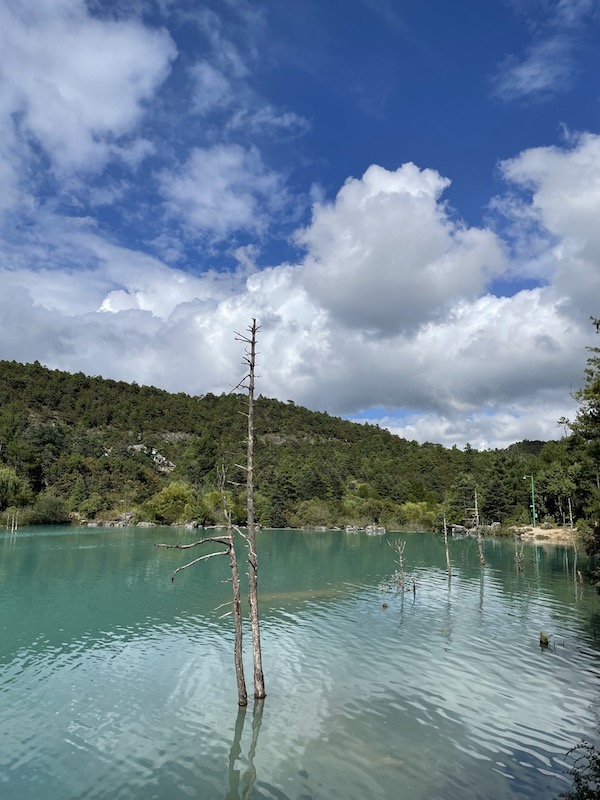
Just down the mountainside from Spruce Meadow, and mostly free of angry livestock, is the poetically named Blue Moon Valley. A white river flows down from the top of the mountain, forming pools of ridiculously blue, almost turquoise, water. A series of waterfalls guide the water through the valley until it eventually ends up in the Yangzi River.
The blue is apparently the result of copper in the rocks, although the water color varies depending on the season and the weather. Some of the water tumbles white over terraced waterfalls which looks pretty cool.
There are parts of Blue Moon Valley that are a little tacky: the Yaks tied to posts for photo opportunities, and the waterfalls that look a little too much like they were crafted out of cement rather than natural erosion. However, once you get further away from the entrance area, you can find both peace and quiet and some truly sublime natural beauty.
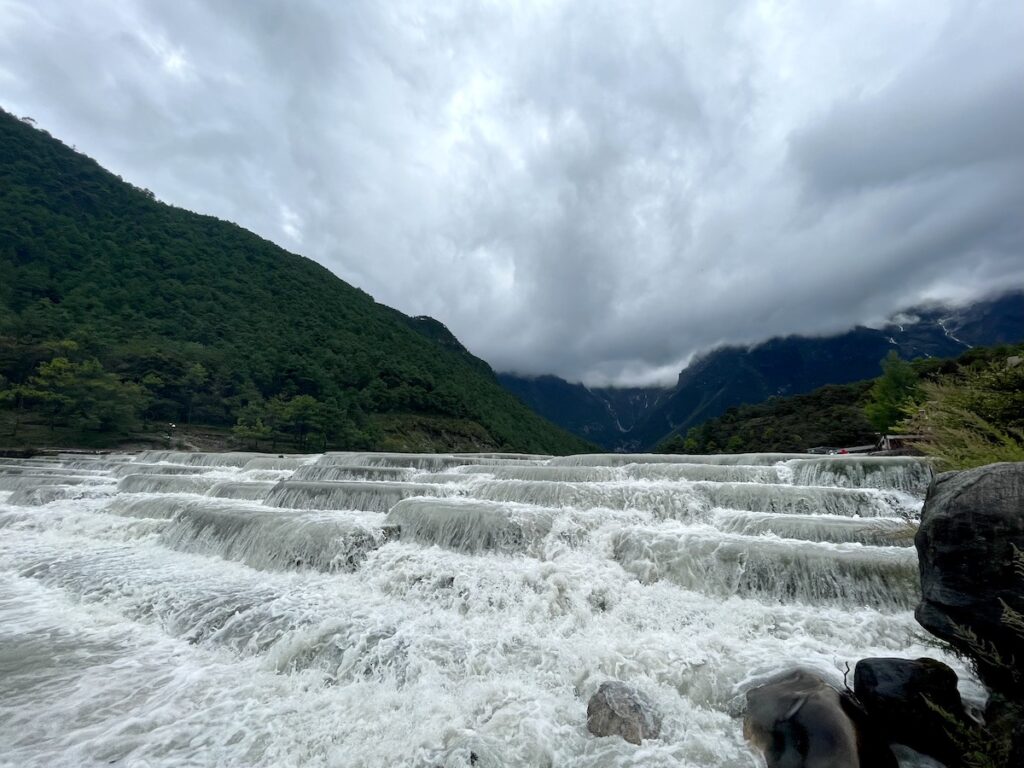
Yak Meadow
Nothing in Jade Dragon Snow Mountain, however, compares to the sublime natural beauty of the Yak Meadow. Not only is Yak Meadow the best part of the park, but it’s also the hardest to get to and the least crowded.
The bus from the visitor center careens down a winding mountain road for about 45 minutes. The turns are sharp and in places, the shoulder drops down the side of the mountain into oblivion. Elsewhere, the pavement disappears and the ride becomes a nausea-inducing endurance test. If you can handle looking out the window, though, the views are absolutely amazing.
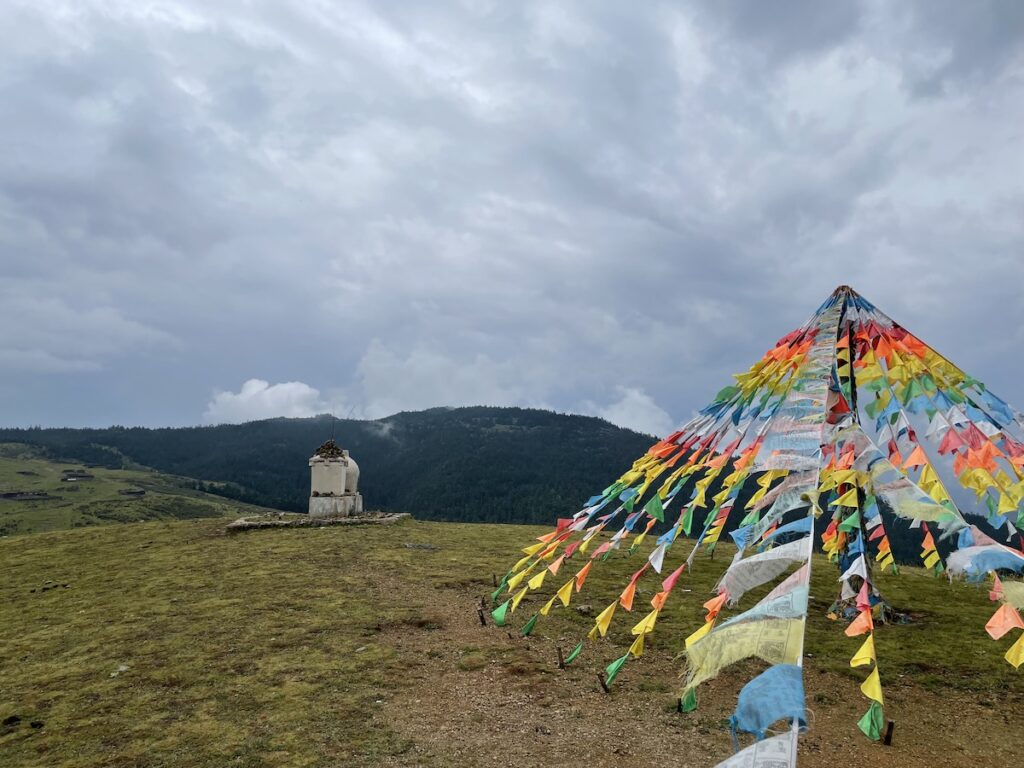
The cable car up to Yak Meadow is open-air and more than a little bit rusty. The views from the cableway are also impressive for those few moments when the clouds part and you can actually see anything.
When we were there, the clouds thickened back together at the top of the cableway. A blanket of light grey mist covered everything. We could barely see ten feet in front of us. There was a wooden platform, a guy selling meat skewers, and a dirt path leading up a hill into the grey. A sign next to the trail warned to watch out for leeches.
We weren’t sure if it was going to rain or not but decided to brave it anyway and walk up the trail, leaches be damned. The trail led up to a rundown Tibetan Buddhist temple that looked like it might fall over at any moment.
Weathering the Storm
The rain came a few yards from the temple entrance. The wind picked up and thunder rattled the mountaintop. It was too far to make it back to the cable car building, so we ran inside the temple.
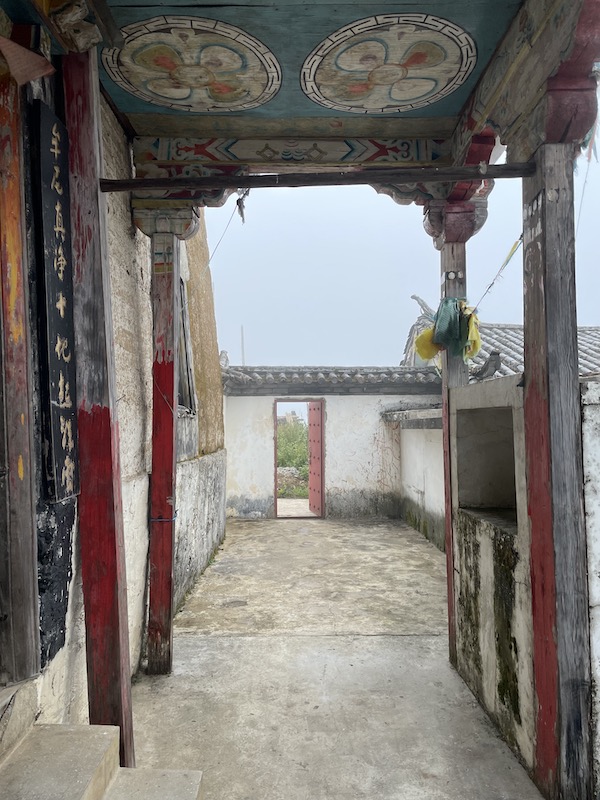
Past the rickety wooden archway that led to the temple courtyard, we found some prayer wheels, a statue of the Buddha, and a crowd of maybe ten Chinese tourists. We sat down under an awning and ate some candy bars and apples we’d stowed away in our jacket pockets. A middle-aged woman accidentally hit me in the face with her umbrella, and we ended up making small talk with her for a little while.
The rain continued and water leaked from the roof and dripped down the walls. Occasional thunder crashed close overhead. There was nothing outside the temple but a wall of grey mist.
Eventually, the storm passed. The thunder stopped and the rain slowed to a light drizzle. We decided to brave the trail.
The dirt trail kept going uphill past the. As the clouds started to dissolve, we could see the short grass of the meadow spreading out around us. Tall green trees hugged the hills at the meadow’s edge. A weathered Buddhist stupa stood on a hill to the right.
The dirt path turned into a wooden boardwalk and eventually led to a wooden platform next to a tent of prayer flags. The mist seemed obliged to finally reveal what it’d been hiding. The peak of the Jade Dragon Snow Mountain began to materialize out of the clouds. Stone ridges, jagged peaks, and the faint white glimmer of the glacier.
The Magic of the Jade Dragon Snow Mountain
I’m not religious, but at that moment I understood why the ancient Naxi people of the region decided this mountain was a holy place. I lost track of the time I spent staring up at the mountain.
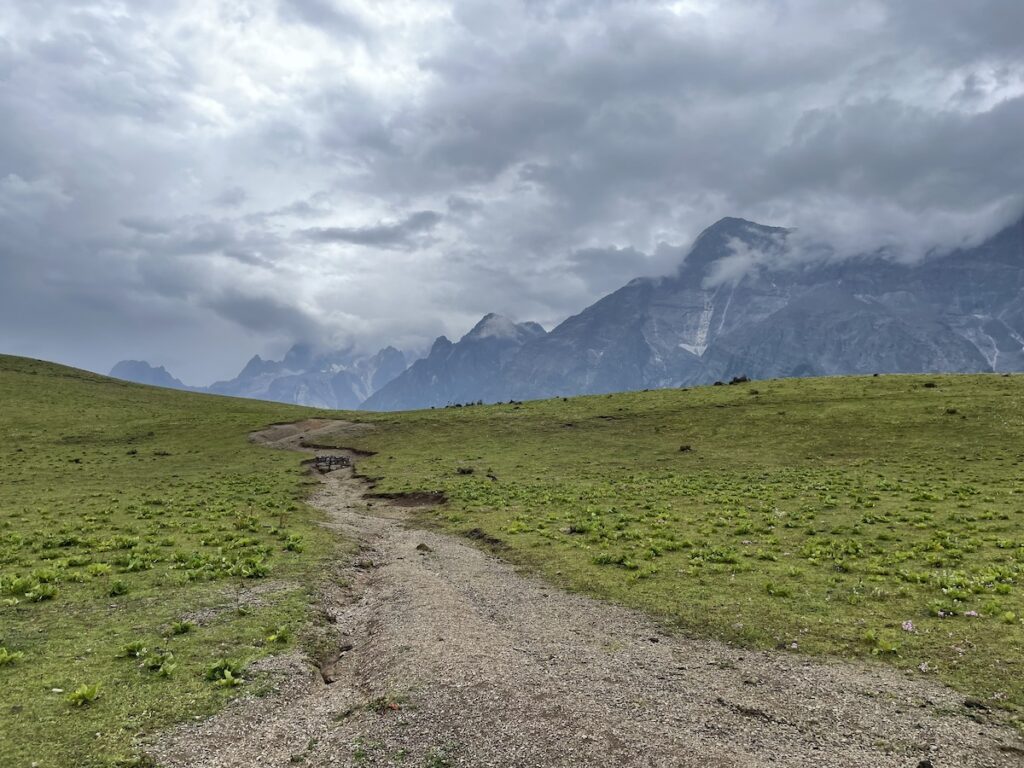
But the mountain wasn’t going to let me just stand there and look at it forever. The clouds returned and the jagged mountain peaks faded back into the mist. It started to rain again, and we walked back through the clouds to head back down the cable car to the mundane world below. We didn’t see any yaks, by the way.
While Jade Dragon Snow Mountain is popular among the Chinese, it seems to be ignored by most foreign tourists. That’s too bad. There aren’t many tourist attractions in the world that can cause you to have a life-changing spiritual experience, even for a short while.
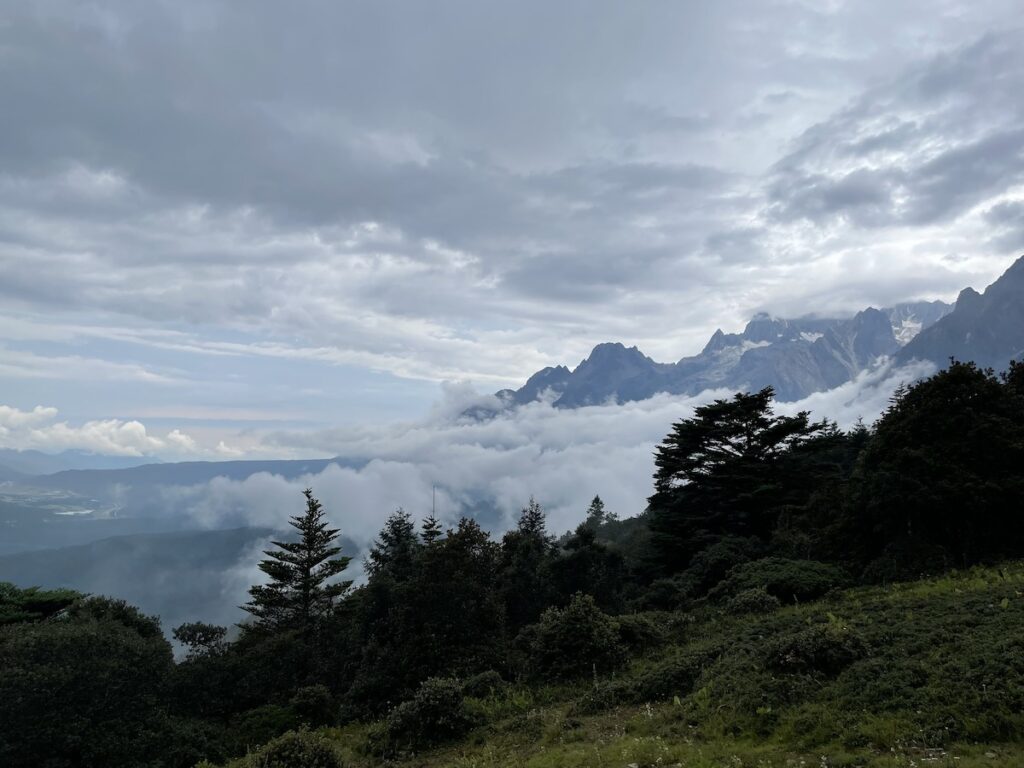
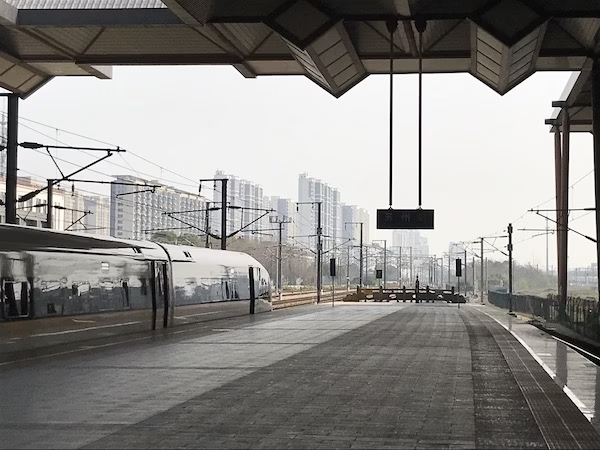
Need Train Tickets in China?
China’s high speed rail network is fast and efficient, but it’s difficult for non-Chinese citizens to get tickets. Fortunately, Trip.com makes buying train tickets as hassle free as traveling through China can possibly be. Click the link below to get your Chinese train tickets. If you buy your train tickets using the link, I’ll receive a small commission and you’ll feel good knowing you’ve helped out an independent blogger.

